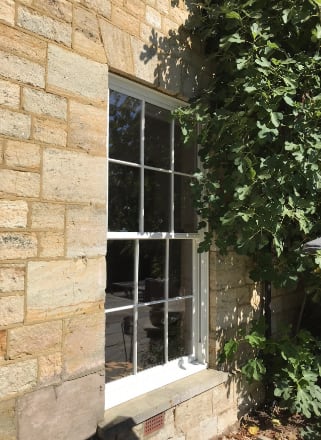We’re taking a break from our regular content about windows to share some fun facts you never knew you needed to know… Thank us later when you’re winning the pub quiz.
1. Fun window fact no1 – A brief history on the oldest known windows:
Believe it or not, the oldest known windows date back to ancient Egypt around 1,300 BC. These early windows were made from translucent animal horn or fine linen soaked in beeswax, providing a glimpse into the outside world while keeping out the elements. They may’ve let the light in but we’re not sure the views would’ve been all that good.
2. Stained glass masterpieces in France:
Stained glass windows have a long-standing history, particularly in religious buildings. Did you know that the world\’s largest stained glass window can be found in the Cathedral of Chartres, France? It covers an area of 2,600 square feet – that’s a little over half the size of a basketball court! The creation of the stained-glass windows in the Cathedral of Chartres is rumoured to have spanned several years; it’s not a wonder when you look at the intricate designs and vivid colours.

3. The origin of window tax:
We\’re not yet done with the fun window facts! This one is going to satisfy a lot of curious minds.
In the 18th century, windows were once subject to a peculiar tax in England and Scotland. Introduced in 1696, the window tax was based on the number of windows in a property. This tax led to homeowners bricking up their windows. Ever wondered what that was about? Now you know. They were bricked up to avoid paying excessive taxes, resulting in some buildings having only a few visible windows today.
4. The invention of float glass:
Before the invention of the float glass manufacturing process by Sir Alastair Pilkington in 1952 – whereby raw materials are melted and then poured to form a flat, uniform sheet – window glass was produced by grinding and polishing large cylinders of glass, something known as ‘cylinder glass’. If you’ve ever wondered why some glass – especially glass in old buildings – appears wavy or distorted, it’s probably because it’s cylinder glass.
Float glass revolutionised the industry by allowing for the mass production of high-quality, uniform, flat glass sheets.
5. Windows as a safety feature:
Of course, windows help to protect from intruders and the weather, but they’re also there as a safety feature in the event of a house fire. Since 1988 (can’t believe it was that late in time tbh!), it has been mandatory in the UK for new homes to have at least one window in each room, apart from the bathroom, that can be used as an escape route.
6. The world’s tallest windows:
The Burj Khalifa in Dubai, the tallest building in the world, boasts an impressive record when it comes to windows. It has over 24,000 windows, each individually hand-cut, and the highest windows in the building are located on the 154th floor, approximately 1,823 feet above the ground. We thank our lucky stars it wasn’t us installing them!

7. Where does the word “window” come from?
The word \”window\” comes from the Old Norse word \”vindauga,\” which translates to \”wind eye.\” This term referred to the small, covered openings in Viking longhouses, designed to allow light and fresh air inside while keeping out the wind and rain.
8. The advent of curved glass
Curved window glass has an interesting backstory that stems from advancements in glassmaking during the 19th and 20th centuries, becoming particularly popular in 50s architecture.
Back then, clever techniques like gravity bending, press bending, and vacuum bending came into play, making it possible to shape glass for those beautiful curved openings.
One noteworthy invention was rolled plate glass, which allowed the production of larger curved pieces. As specialised machinery entered the scene, mass production became a reality. And voila! Curved window glass now takes centre stage in modern architecture and automotive design, adding that extra touch of style and versatility.
Did you know that the Apple HQ building has the world\’s largest curved windows? This is how they were created.
Isn’t it fascinating how something as simple as a window can hold so much history and significance? From ancient origins to their impact on art, literature, and even taxes, windows have a captivating story to tell.
So, the next time you find yourself staring into space out of a window, take a moment to appreciate the craftsmanship and innovation that have shaped these everyday pieces of glass. Whether it’s the beauty of stained glass, or wondering what’s up with the ripples in the window of ye olde pub.

